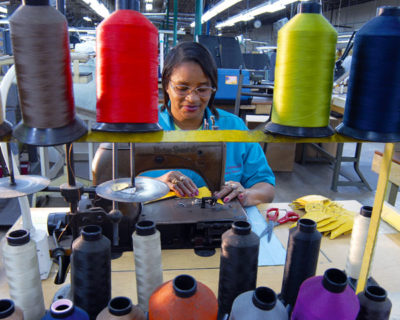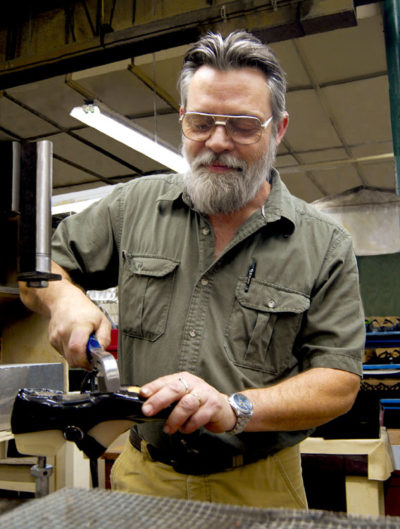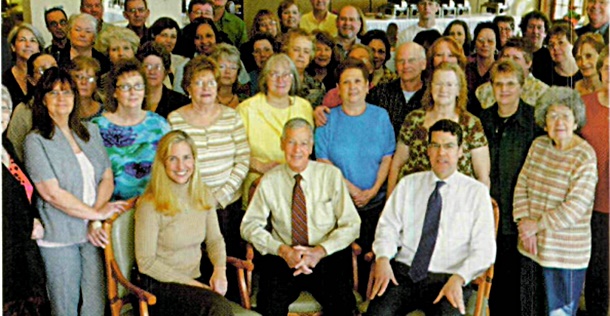It was 1985. Munro & Company’s competitors were closing American factories and shipping their shoe manufacturing operations to China.
American companies were paying their workers $4 or $5 an hour for a 40-hour week, and Chinese workers were paid $10 a month for a 56-hour week. Munro & Company faced pressure to lower its prices or lose business. Munro founder Don Munro did not want to go overseas. He believed in buying American, insisting on purchasing American cars and TVs. He did not want to close factories, lay off workers, and move jobs out of the country.
“He has always been appalled at the unwillingness of people to understand what happens when you give away your manufacturing base,” says his daughter, Mollie Munro, vice president of the 37-year-old, Arkansas-based company. “That’s when he pulled in my two brothers, my sister, and me. He said, ‘Look, I’m not willing to go overseas. You guys have to figure out a way to make this work.’ ”
As their competitors’ prices plunged, says Mollie Munro, the only alternative they saw was pursuing a specialty niche —they’d make shoes for women with especially small, long, thin, or wide feet. They would no longer be able to sell to Wal-Mart, Sears, JC Penney, and similar retailers because the company was not willing to manufacture in China to lower its price.
At that time, the company made “old lady shoes” for private labels, Mollie says. So they decided to start their own line of shoes under the name Munro American and expand to offer 40 styles, most of them feminine but not flirtatious. And their sweet spot, they decided, would be women whose foot size fell outside of the norm.
For each style the company sells, there are 75 different sizes—from 4 to 14, from super slim to wide wide. (The typical mass-producing manufacturer makes 17 different sizes per style, she says.)
Munro & Co. sells its women’s shoes through specialty retailers and Nordstrom, the company’s largest single client.
Through primarily word-of-mouth advertising, they have developed a loyal following among baby-boomer teachers, business women, real estate agents, and government workers who are on their feet a lot and want to look professional.
“They’re power shoes,” Mollie says. “They’re shoes saying that what I do is more important than how I look.”
Teachers are not collecting six-figure incomes, so how can they afford to pay $130 to $200 for a pair of shoes? Mollie says the shoes not only project an image of confidence and competence; they are quality, comfortable shoes that last for years, making them a good value.
Commitment to America
Munro & Company survived its decision to keep manufacturing in America, but not without serious cutbacks. Its work force shrank from 2,200 and seven factories in 1982 to about 530 employees, three factories, and a distribution center today. There were years when the management staff took a 10 percent pay cut. Some years, the family-owned company reduced the company’s matching contribution to its employees’ 401(k) plan, but restored the match when times improved.
The company’s health plan is self-insured, so in the years where demand for medical care exceeded employees’ contributions, the company supplemented with operating funds.
But the ability to offer a self-insured health plan has been not only good for employees’ health, it also has been good for the bottom line, says Stan Grise, vice president and chief financial officer.
“If we have [a request for] a particular kind of medical procedure that makes sense medically and financially, we pay for it. We don’t have to go through the approval of an insurance company,” he says. “Quality medical care costs less. We avoid the bureaucracy and red tape that’s involved in an insurance plan.”

The health plan exists to serve the employees’ medical needs, not make money, he says.
To weather the economic downturn, all travel has been cut by 10 percent the past year. The company has reduced production expenses by eliminating overtime, cutting 10 percent of its labor costs. It had to lay off about 6 percent of the work force in December.
“We stay pretty fiscally tight,” says Mollie, who runs the business with her older brother Bruce, the chief executive officer. Her father, 82, is chairman of the board and busy with philanthropic endeavors, leaving day-to-day operations to the next generation. The other Munro siblings have left the company, one to start a separate, related com-pany—Neil M. Footwear, maker of high-end men’s shoes and boots.
With what some economists call the worst economy since the Great Depression, Munro & Co. faces another challenge. Competitors that once ignored the specialty-size business have entered the market with shoes made in China for a fraction of Munro’s cost.
Munro has stuck to its practice of using quality leather and letting it sit for four to 12 hours on the plastic foot form, called a last, a process which ensures the shoe holds its shape and lasts for years, Mollie says.
Shoes that are mass produced in China, she says, are generally left on the lasts for 45 minutes, which doesn’t allow the leather a chance to set. “So when you wear the shoe, your foot stretches the leather,” she explains. “It’s not going to wear as well.”
Another factor that has allowed Munro & Co. to stay in business is not having to answer to shareholders, says Grise, who has been with the company for 23 years.
In these tough economic times, when retailers are reducing their inventory to remain profitable, Munro felt it was crucial to be able to offer its customers the wide range of shoe sizes they’ve counted on. The company known for carrying difficult sizes could not afford to have stores stock fewer sizes.
Munro had to find a way to remain on the shelves when retailers looked to trim costs.
“We’re going to make a smaller profit so the retailer can make enough money to keep the brand,” Mollie says. “If they can’t make money on you, sooner or later you’re going to go. That’s how a little, nobody-company like Munro manages to survive. We make them money.”
Another quality Munro offers, Grise says, is the ability to be hyperresponsive to its customer. For example, when one of its retailers calls before 10:30 a.m. to place an order, the order is shipped the same day.
“That allows our independent retailers not to have to carry as much inventory,” he says. “That quick response is something that competitors can’t offer.”
And they have never lost sight of their customer—the woman who wears their shoes. Bruce and Mollie Munro, as well as their sales staff, travel regularly to stores and talk directly to the customers about the shoes. Mollie meets customers at trunk shows about 75 days a year.
“We listen to the consumer and try to give them what they are not getting from the competition,” Grise says.
Nordstrom’s Jack Minuk, executive vice president, general manager for the shoe division, says the retailer enjoys working with Munro. “Munro
shoes have a large and loyal following with many of our customers,” he says. “Probably the most outstanding attribute of Munro is the superior fit these shoes provide to a range of customers.”
Munro believes “true expertise comes from the factory floor. We have never hired a designer. We have tons of engineers. They are all trained in the business,” she says. They learned about how shoes were made firsthand. “If you don’t understand how shoes are made, you’ve got no business designing shoes.”
Long-Term View
When Mollie was fresh out of college and new to the business, her father said: “There are two reasons to own a business. One is to make money and one is to be in business. I always chose the latter. My decisions have been predicated on staying in business.”
The Munro family has put the longevity of the company ahead of their personal wealth. “I do think principle is a much stronger motivator than money,” she says.
Don, Bruce, and Mollie Munro will not take a raise until the business is profitable, she says.
In good years, the profits are saved as a cushion toward the lean years, Grise adds.

In 1975, there were more than 1,000 shoe factories in the United States, and about 40 remain, Bruce Munro says.
“I think the single biggest factor that keeps us in a competitive position versus a lot of other companies is that we’re a private company, not a publicly traded company,” Grise says. “Don Munro has never been greedy or anxious to take money out of the company.”
Since 1992, Munro & Co. has had asset-based borrowing with its bank. This means the bank grants loans using the company’s existing assets as collateral. This reduces the risk to both the lender and Munro, and that has helped the shoe company weather financial storms, Grise says. “Our critical mass was strong enough that during the toughest times, we had enough staying power to draw on.”
Fewer than half of the past 10 years have been profitable, Mollie Munro says. “As long as we can make payroll and pay the bank, we’re fine.”
The company has made decisions that hurt short-term profits. For example, in 1991, the company bought a factory out of bankruptcy. “We knew it wasn’t the greatest business decision,” she said.
When Don Munro went to look at the factory, the employees who had not received their last paycheck were sitting outside, angry and defiant. “My father wrote a check on Christmas Eve so those people could get their paycheck and go buy presents for their kids,” she says. The factory never turned a profit.
The factory made shoes for small children, whose feet grow so fast that shoes have to be replaced every few months. When parents stopped buying $100-shoes, Munro & Co. made the choice that to keep its Jumping Jacks business alive, it would have to transfer manufacturing to China, she says.
Munro & Co. continues to face challenges. Because some 92 percent of shoes purchased in the United States are made in China, the raw materials are manufactured there, Grise says, forcing Munro to import its leather and other materials from China.
China does not have the health, safety, and environmental laws that exist in the United States, allowing Chinese manufacturers to use an adhesive with more staying power than the adhesives permitted in America, Mollie says.
Furthermore, Munro executives, Grise, and their bank are well aware that even well-established, successful retailers have gone bankrupt. If any of their retail customers were to stop carrying their shoes, Grise says, they have contingency plans in place.
As long as they ensure that their ultimate customer —the women buying their shoes —is happy, they expect to continue.
There may come a day when Munro & Co. has to forgo American manufacturing, but the company would only do that as a last resort.
“We are doing everything we can to avoid going overseas for the manufacturing of our Munro American brand of women’s shoes,” Mollie says. “As long as enough of our customers believe that our shoes offer a good value for the price, we will be able to stay domestic.”
What happens When Jobs Leave? Read how two different companies led by extraordinary men with old-fashioned corporate values adapt to the issue of succession and changing market forces.
Links
MunroShoes.com
Store Locator – Where to Buy
Become a Saturday Evening Post member and enjoy unlimited access. Subscribe now




Comments
The best made shoes ever. I have a narrow foot with an extremely high arch, Munro has never failed.
I do have a wish that Munro bring back the wedge shoe from several years ago made from stretch fabric with leather accents at the heel and toe. Always a loyal customer.
Debra N
You are a survivor, just like my mother. She gave us the best childhood and for that I thank her everyday. She has been to hell and back and is a survivoras well.
I have just discovered Munro shoes. I bought the Munro Evie style because the neutral style appealed to me and I liked that I could wear them every day to work and no one would think they were women’s shoes. They are the most comfortable shoes I have ever worn, and after 5 days of wearing them, I went back on Zappos and ordered the one remaining pair in my size to save for the future. I feared that I would not be able to find them again when the first pair wore out. They look great and feel great. I think Munro American should market some appropriate styles to men. They are a bargain at the price I paid for them. I would gladly pay more if I had to. Thank you Munro!
I have been wearing munro shoes for about 6 years. I’m a 6-1/2 W, not a particularly strange size, but they are the most comfortable shoes and always look professional. I hope they never go out of business. I don’t mind spending more for them because they are made in America
I am a mail and I buy many pair of the unisex type munro shoes as they are so great well made and comfortable to wear the 13ww and 14w or ww fit me well I wish they still made the size 14 ww I have all the munro T straps and others shoe 50 pairs in all. Love them.
I have six toes on one foot and weigh over 400 pounds. These are the only shoes that fit and make me feel like a lady.
I love Munro’s shoes-They’re very comfortable, and they’re not made in China. I’m tired of everything being made in China and was delighted to discover that Munro’s are made in the U.S.
What is the phone number for Munro Co.?
More than half of the last 10 years..the company has lost money?? Sounds to me as if the company needs new management! When it comes to survival, nepotism should out the window!
I wish my brother would have live to read the story about Munro &Co.He fought in world war ll and he could not stand it that he could not fine made in America stuff. As the years went by it got worst. So when he pass a way the grandkids could not believe he had no new shirts and things because he couldn’t fine them made here
I work for an Australian manufacturing company (ANNA FIORI)that is experiencing the same challenges as Munro. They to have resisted the “China Syndrome”, but as I see the owners wilting under the pressure of trying to find orders I wonder wether morals, loyalty and ethics are eventually going to be their downfall
More information on Munro Shoes can be found on their website, http://www.munroshoes.com.
My wife wears a size 10 quad, where can we go to buy this size.
I have an out of ordinary size foot. It got so it is so hard to find shoes to fit me. Where can I get monro shoes. I am female.
What a testimony. Can you imagine how much better our manufacturing economy would be if our American workers could have had those many thousands of jobs.
Most of us are now looking for all clothing as well as shoes that are made true to size. Also something that does not lose it’s shape after on use.
We are proud of you and wish you continued success in all your plants.
I am a former employee in the shoe business, and a Italian Designer, they never gave up quality or materials to cheapen the price. It is refreshing to see one American company with the same mind set. In the 80s every one was saying we have to go overseas to compete,and none of them are still around, good for you stay strong on the mind set.